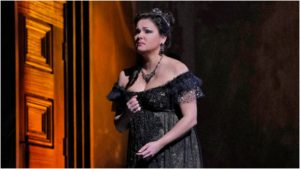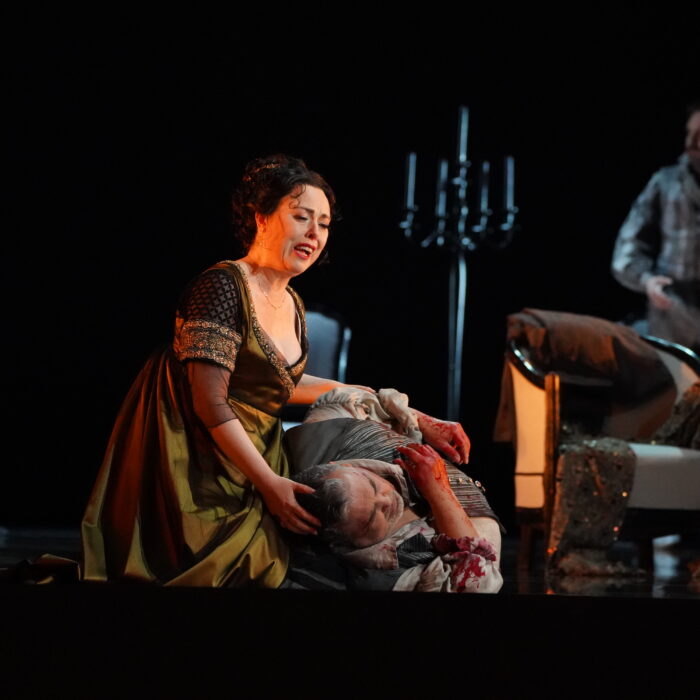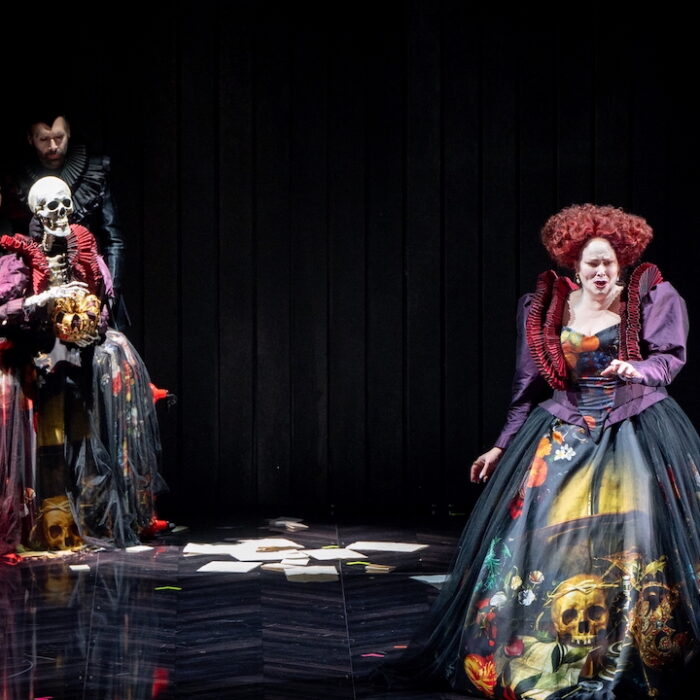
Metropolitan Opera 2017-18 Review – Tosca: Anna Netrebko Conquers Puccini’s Iconic Diva
By Francisco SalazarWritten in collaboration with David Salazar
It’s been years in the making – Anna Netrebko singing “Tosca.”
The soprano has been outspoken about her dislike for the character and about her doubts singing the role, but it’s a character that audiences have been dying to see her sing. Afterall, who but Netrebko can be considered the quintessential diva of the modern opera world. A soprano who seems ready to surmount any obstacle or challenge. A diva with a temperament that is a ton of fun to follow on social media. Likewise, the character of Tosca proves to be one of the fascinating contradictions of the canon, the pious, jealous and insecure woman who nonetheless has the willpower to murder a sexual abuser before ultimatley jumping to her doom in the face of tragedy. It seemed like a match made in heaven and at the same time you’d have to wonder how it would work.
The answer? Let’s call it Anna Netrebko’s masterpiece.
The Production
But before we get there, let’s take the scenic route, specifically down memory lane.
When Sir David McVicar’s production premiered in December it was far from a rousing, visceral concoction. It often felt tepid, unfinished and overly improvised in terms of blocking. It lacked in violence and tension. While it improved as the run went by, there were still details that seemed unusual and unnatural to the production.
But on this evening the realism that McVicar was seemingly attempting four months ago finally came to life (and he wasn’t even directing it). Gone was the Act one shawl dropping to the floor without purpose, the incessant walking around the stage without intention or payoff in Act two, and there was finally a sense of immediacy and desperation in the final jump in Act three. Gone was the awkward exchange between Cavaradossi and Tosca in the torture scene where Tosca is downstage and Cavaradossi is upstage in the torture room and they are “whispering” to one another.
The blocking remained mostly intact but had greater clarity of intention and corresponding execution. One sore spot of that first run (from start to finish) was always Tosca’s run around the table when she stabs Scarpia a second time – it just felt overly choreographed by the director. Here we understand and feel the action. We see Tosca back away from Scarpia after the first stab, using the table as a shield of sorts. Then we see her run around it to stab him again when she sees him inching toward the door calling for help. Same action, but clear and effective.
There were also a number of subtle changes in the costume department that improved the aesthetics of the production as well. Instead of the white dress from Act one that didn’t quite work and in came a regal beige gown with a sky blue shawl that Tosca wears over her head when she first enters the stage. In Act two, Tosca got a tiara, giving her more of an imposing presence.
But whether or not there were changes, part of the success of McVicar’s production was due to the casting of its three leads.
A Revelation
As Cavaradossi, Yusif Eyvazov took over the run for an ailing Marcelo Alvarez and the results were marvelous. Eyvazov has a unique timbre that can sometimes sound rough and raw and for some, this may not be the ideal voice for the Italian rep. But regardless, this a tenor with a large instrument who is built for this repertoire. More importantly, he’s a very intelligent singer with a stable sense of rhythmic precision and nuanced phrasing.
On opening night Eyvazov had some chilling moments like his “E Lucevan le stelle,” during which he immersed himself in the subtleties of Puccini’s lines. Often a vehicle for tenors to blast their sounds with wild abandon, Eyvazov chose a more delicate and introspective approach. He began the aria with piano singing stretching each moment as if it was truly the last, the low notes sounding full and comfortable. As the aria grew in intensity, so did his voice in peaks and valleys, building and falling in a sobbing manner. It wasn’t a massive passionate display and instead of laying his heart bare for all to see, he pulled you into a more internalized pain and suffering. When he threw off the final “La vita” at the close of the aria with accented abandon, it felt earned; he had been building up all the emotion inside, creating tension for release, and finally let it all out to cathartic effect.
Also beautiful was his “O Dolci mani,” where he sang delicately throughout, his voice remaining more subtle in its singing; it felt like an intimate moment for the two of them, and was also consistent with his characterization of Cavaradossi in his preceding “E luce van le stelle.”
His “Recondita Armonia” was quite the opposite. Here Eyvazov began with brighter colors and impassioned tenderness bringing the aria to a climatic B Flat. It wasn’t necessarily as varied or richly psychological as “E Lucevan le stelle” or “O Dolci mani,” but as far as declarations of impassioned love go, it was pretty potent.
Eyvazov was also particularly strong during his heroic “Vittoria, Vittoria” singing the moment with intensity and vigor and holding the notes with power. His ensuing lines were equally as powerful ending it in parlando phrases because he has the weight in his lower register as support. This is often a trouble area for more lyric tenors taking on the role, their voices drowned out by the orchestra, forcing them to push out the low notes without much support. But Eyvazov managed it quite well.
In his duets with Netrebko, Eyvazov sung with tenderness and legato phrases that blended well with her soaring voice. His phrase “Quale occhio al mondo” in Act one started off with a warm mezzo forte tone rising to the soaring forte. It was passion at its fullest and it would only continue throughout the evening.
Demonic Scapia
As Scarpia, Michael Volle was an imposing figure both physically and vocally. I’ve rarely heard “Un tal baccano in chiesa” sung with more authority or booming presence. He had me hooked right then and there and he never lost control. That is, until someone else wrestled it from him (more on that later).
In his first Act duet with Tosca, Volle loomed over Tosca with elegance and pose. He sang with a more refined tone almost as if trying to seduce the jealous diva. Before Tosca exited the church, Volle grabbed her shawl holding on to it with strength. From this moment one knew who had control and Volle’s lustful glance showed what was in store for Act two. During his “Te Deum,” Volle sang with strength and vigor taking control of the stage. That you could hear his voice loud and clear through the blasting chorus exemplifies the kind of power he exhibited throughout the night.
In Act two Volle finally let loose his ominous figure, taking Tosca and physically abusing her. He was not afraid to pull her by her hair, force her to drink wine, grab her by the neck or simply grab by her arm. Each time the actions would become more violent and the tension growing.
But one doesn’t feel that if Scarpia’s actions don’t grow. And Volle knew how to transform each moment. From the onset of Act two, he loomed over Tosca following her throughout the room whether it was physically or with his eyes. He never let go of her and that made the scene even more uncomfortable. One sensed the predatory nature. Vocally his baritone started the Act with a seductive timbre in his first aria, growing into a potent tone that easily resounded throughout the Met. But in other moments Volle snarled at Tosca with cynicism and sarcasm. One of the most tension-filled moments of the evening saw Tosca and Scarpia seated at the table as Tosca asks Scarpia “Quanto, il prezzo.” You could feel Volle completely surprised by the question and his actions unpredictable. And this unpredictable nature is what made Volle’s Scarpia such a threatening force.
The Diva
And now, Netrebko.
The Russian diva has always been a charismatic singer bringing depth to characters and vocally alluring audiences. But as of late she has grown vocally and as an actor. She poses subtle nuances that give each character a different quality one would usually not expect. And with Tosca that was the case.
When she entered the stage, she was youthful, playful, seductive and jealous. But she wasn’t that imposing and domineering Tosca one comes to expect. She didn’t overplay the jealousy or the diva antics in the exchange between Cavaradossi. Instead, she made Cavaradossi chase her around the stage ultimately seducing him. Her voice had a lyric and light quality that created that playfulness and which reminded us that Tosca is more than a diva. Netrebko’s voice continuously grew in strength through her first duet with Cavaradossi but she always maintained that innocence and youthfulness in her characterization.
In her subsequent duet with Scarpia one sensed a power struggle between Volle and Netrebko. It was an interesting interaction as you could sense Netrebko turning to Scarpia for emotional support at times – it opened the way for him to seize control in the second act. Without a built-in sense of trust from the start, we can further understand why she trusts Scarpia’s claims and runs off to Mario. Moreover, it makes her more vulnerable at the start of the ensuing act. Netrebko’s voice grew dark and her lines “Egli vedi ch’io piango” were full of heartbreak and as she walked off stage leaving the church, she left with despair.
In the second act Netrebko’s Tosca entered with poise and calm. She sat on a chair downstage with elegance and engaged to converse with Scarpia. Her opening lines were equally calm and as her interaction with Scarpia became heated, she quickly moved away from him as he loomed over her. The lightness in her voice quickly evolved into a powerful spinto sound that easily soared through the Met stage. Her powerful High Cs gleamed and each line continuously expressed the powerlessness of Tosca. Netrebko’s attempts at escaping Scarpia were continuously defeated and at one point Volle took her by the neck while she was seated on the floor making for one chilling moment after another.
But what was most chilling was the murder. Netrebko walked over to the seat, drank a glass of wine and when she spotted the knife, she walked over to it slowly and carefully. She took a glance, picked it up with a meditative look before putting it down. She then prepared herself and when Volle’s Scarpia went towards her, she took the knife and stabbed him intensely.
Her reaction to his death was perhaps the most fascinating of all her psychological insights on the character. Whereas most divas would shout the words “muori” to the top of their lungs, Netrebko was more subdued. She spoke them with a sense of terror and her reaction was equally that of a frightened woman, lying on the floor. You could sense that while frightened, she was also privy to the fact that she could be overheard. Afterall, she just stabbed the guy a second time when he tried to run to the door begging for help. It took her a few moments before she went to wash her hands and look for the “salvocondotto.” It may have followed the traditional and predictable staging one expects but in the hands of Netrebko one understood the fear and powerlessness of this woman.
In her “Vissi d’arte,” Netrebko took a quicker tempo than one would expect. Her opening phrase expressed pain but she always maintained the subtlety in Puccini’s music. While there were some imprecise rhythmical moments, as the line grew, her expression did as well making for a passionate and showstopping aria. I haven’t heard quite the ovation for any other diva this season as I heard for Netrebko after the famed passage.
One interesting thing about Netrebko’s interpretation was the lack of emoting. Whereas it has become a tradition to emote certain phrases like “Quanto, Il Prezzo” or the phrase “O Dio,” Netrebko opted to vocalize them and use her instrument to create the same emotion. It may not be to anyone’s liking, but it also emphasized Netrebko’s consistent characterization of the famed diva – instead of being a woman defined by desperation, she was a desperate woman fighting to seize control of the situation.
In Act three, the soprano started off a bit restrained vocally and there was one high note she cut short. But Netrebko quickly came into her own. While there was still that sound of fear from murdering Scarpia, her subsequent phrases in “Senti l’ora e vicina,” saw light and brightness return to her timbre. And it all concluded in a heroic a capella “all’estasi d’amor.”
As she watched the murder of Mario, Netrebko was subdued in her “Ecco un artista” as she was trying to hide their plot to run away. And when she discovered Cavaradossi’s corpse, Netrebko’s reactions were that of pain but she never overdid the ensuing phrases. Netrebko ran downstage looking for an escape only to be trapped. Her final “O Scarpia, Avanti a Dio!” was sung with rousing and a triumphant sound. Netrebko raced to the edge jumping for an arresting and dramatic finale.
A Propelling Force
After having conducted two shows in less than 24 hours Bertrand de Billy was doing his third performance of the weekend and that is heroic. More importantly, De Billy proved extremely captivating in Puccini. He conducted with force, passion and always moved the music forward. In the suspenseful Act two, the Maestro followed each singer, never pushing them to their limits or covering them. But he emphasized the brass when it was needed and always made sure Puccini’s rousing climaxes were pronounced. He also pushed the Met Opera chorus to extreme heights during the “Te Deum.”
All in all Anna Netrebko proved she was born to sing “Tosca.” Together with an exceptional cast, this evening was one of the most thrilling the Met has put on the whole season (and in recent seasons, to be honest). Met audiences are in for the treat with the remaining performances but it’s a shame audiences around the world won’t get a chance to see it on HD, as this cast certainly deserves to be preserved on an audiovisual medium.


